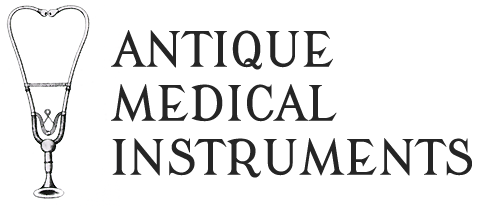My bid of 800 Euros failed to be the win bid for a 5th edition John Scultetus “Armamentrium Chirurgicum” which sold for 1100 Euros.
Dr. Scultetus, actually Schultes or Schultheiss (Born October 1th, 1595 in Ulm, Died December 1645 in Stuttgart ) was a German doctor and author of a book for surgery and their instruments entitled “Armamentarium-Chirurgicum” in 1655.
Now as any smart collector of any collectible will tell you, having a copy of the original trade catalog of whatever it is you collect (in my case medical and surgical antiques) is of high value so you can identify instruments which you wish to collect or have obtained.
Realistically, “Armamentarium-Chirurgicum” by George Tiemann and Co. 1879 is the “bible” of antique medical catalogs to own for most American collectors.
The fact of the matter: finding medical and surgical antiques from the 1600s to 1700s is rare. They just did not make that many at the time. The United States’ doctor or barber or surgeon, in the latter 18th century, had no fine instrument makers from whom to buy medical or surgical equipment, this all came over from Europe and the good medical or surgial or apothecary items were–and still are–rare and expensive.
My collection of medical antiques is based mostly on items from the 1800s and 1900s–medicine’s golden era–not that I do not want some older items (and I have a few), but they are rarely found and mostly in museums if they are of any quality. Moreover, differentiating surgica antiques like a medical bone saw vs a carpeter’s saw from the 1600s or 1700s takes a keen eye and knowledge as only the finest of surgical items of that period were marked by an instrument maker.
The above historical context is not meant to educate, anyone reading this–are you out there, who knows, Google Analytics says you are–should know the above if they are an experienced collector of medical antiques.
My point is that I have run out of items that I “need” for my collection and am branching out into antiquarian medical books–a very expensive proposition and one I really cannot afford. Antiquarian book collectors have way deeper pockets than us medical antique collectors. I would guesstimate tht qulaity antiquarin first edition medical books cost 10 to 100 times more than the instruments they depict. Crazy, right?!
So why did I bid on the antiquarian book? Good question. I do not read German. I can get modern reproductions of the book for under one hundred USD. Antiquaran books, like any investment, are far from guaranteed to increase in value; in fact, I read some articles stating the stock market offered better long time returns than antiquarian books in the big picture.
To answer my ow question, I like the idea of owning the original work by the author who created or documented use of the original medical or surgical antique. A bad idea since even if I could afford it, it would only sit on my shelf, I could not “play with it” as these books should be handled very delicately–in fact, that is why book collectors keep a “reading copy” to thumb through and a “rare copy” which sits on their sheves, untouched, except for the advised dusting every 3 months.
So have I changed my mind about wanting antiquarian medical books now that I have spewed iut the above. Heck no! I am a collector and suffer from the pathology hat once he idea is seeded, it is almost never quenched until the item is obtained. Time to start putting more coins in the piggy bank.

